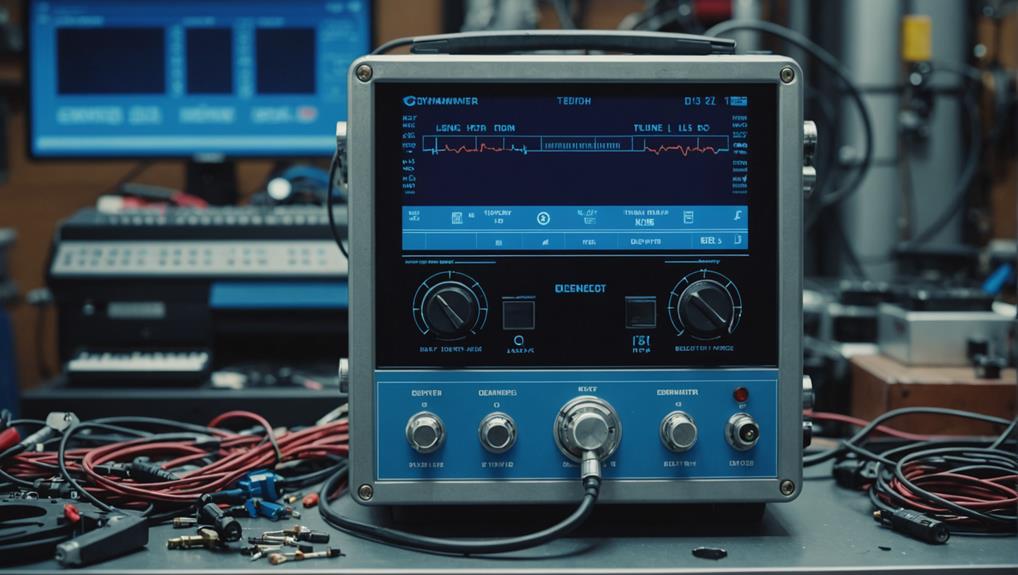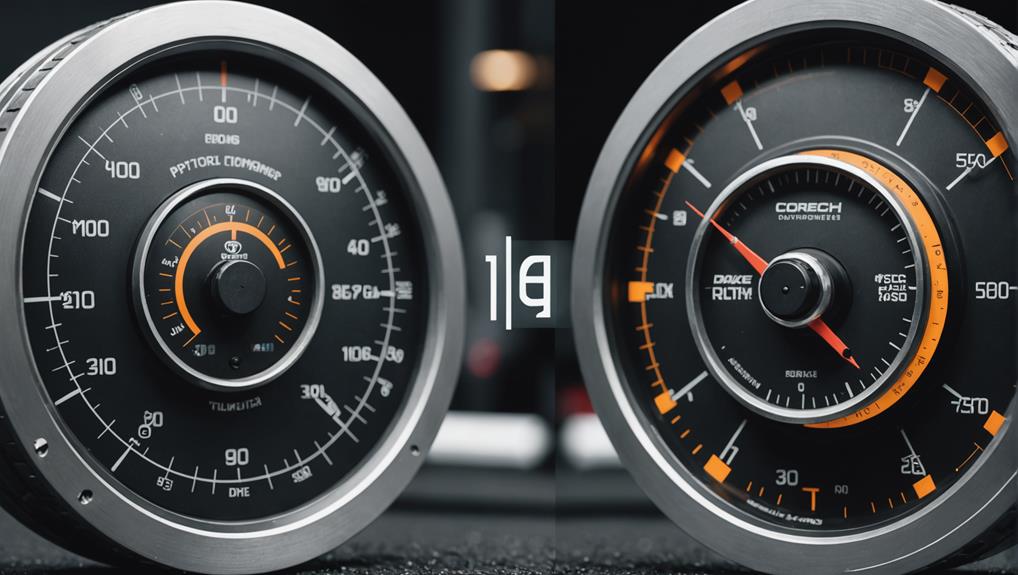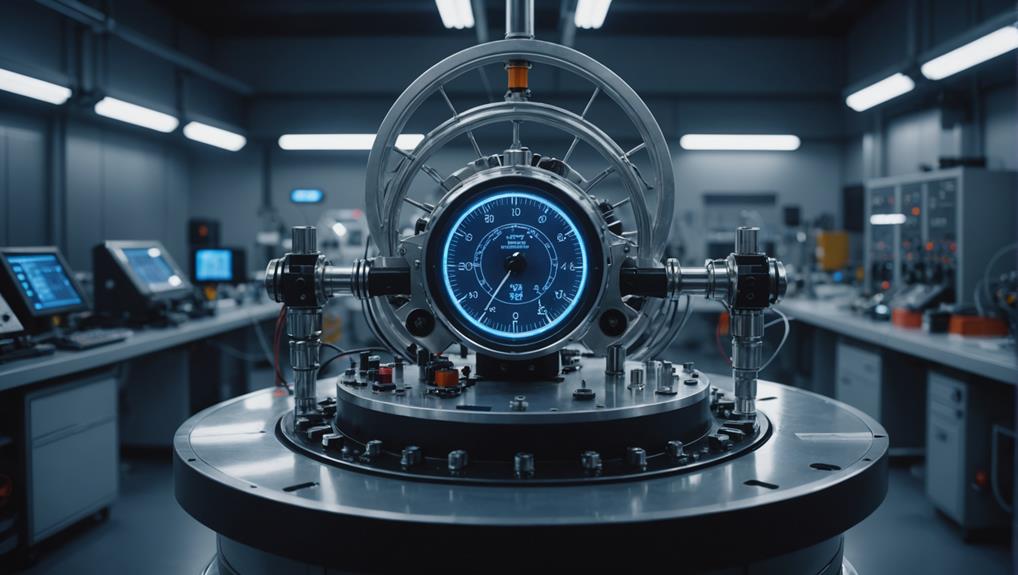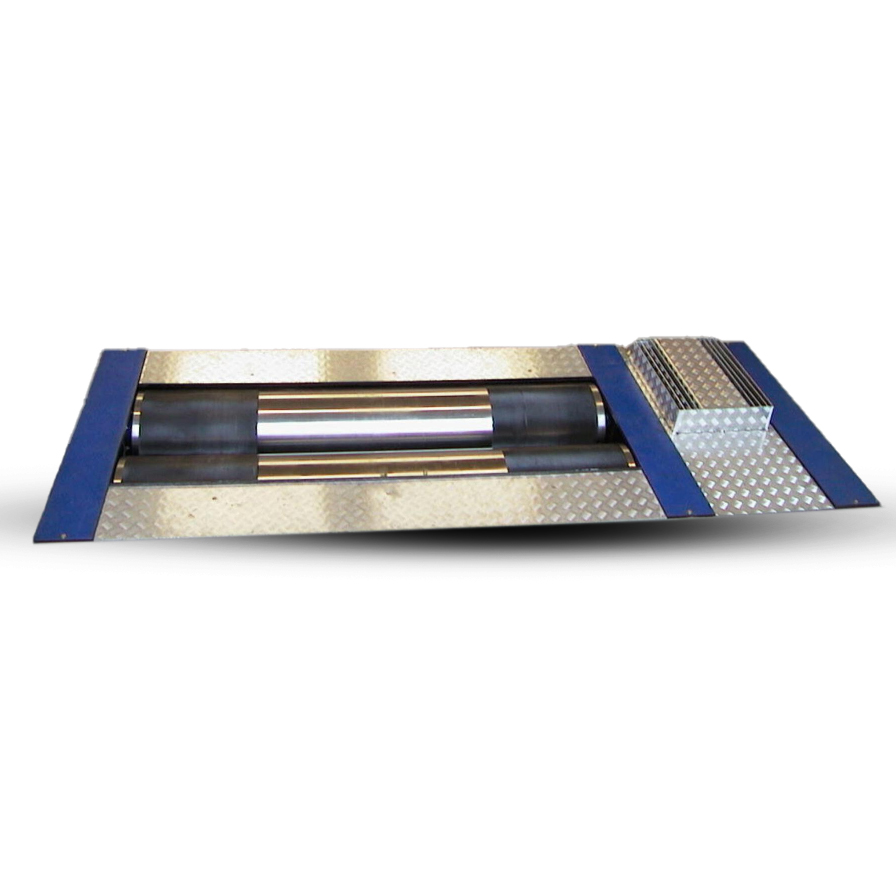
How Dynamometers Enhance Engine Diagnostics and Testing
Necessitating precise measurements, dynamometers unlock the secrets of engine performance, but what else can they reveal about engine diagnostics and testing?
Dynamometers have emerged as the gold standard in muscle strength testing, offering a precise and reliable means of measuring muscle strength.
They provide accurate and consistent estimates of muscle strength, enabling researchers to better understand extrinsic risk factors that contribute to repetitive strain injuries.
In contrast, manual muscle testing is hindered by limitations that compromise its accuracy and reliability, including intra-rater reliability issues and inter-rater validity concerns.
When selecting a testing technology, factors such as reliability, validity, population, and complexity must be considered.
Recognising the distinct advantages and limitations of each technology, clinicians and researchers can make informed decisions and uncover the full potential of muscle strength testing.
Centuries ago, manual muscle testing (MMT) originated in China, later evolving in Sweden in 1860, and American physician Dr George H Taylor published a key precursor to MMT techniques in 1860.
Since then, physical therapists have contributed to modern MMT techniques, which are widely used in rehabilitation settings to assess muscle strength, often in conjunction with hand-held dynamometry.
The measurement of muscle strength has undergone significant transformations with the development of dynamometers.
In the 19th century, mechanical devices were developed that measured muscle strength by applying a known resistance to the muscle.
In the early 20th century, strain gauge-based dynamometers were introduced, which used electrical signals to measure muscle force.
Later, isokinetic dynamometers emerged, allowing for the measurement of muscle strength at a constant velocity.
However, research has shown that manual muscle testing has intra- and interrater reliability and validity issues.
This has led to the development of more objective methods of measuring strength.
The evolution of dynamometers has addressed these concerns, providing a more accurate and reliable means of measuring muscle grip strength and comprehensive muscle function.
Variability in muscle strength measurement has driven the development of distinct types of dynamometers, each with its own set of advantages and limitations.
This disparity enables clinicians and researchers to select the most suitable tool for their specific needs.
When measuring grip strength, different dynamometer types exhibit varying levels of reliability.
Fixed dynamometers measure strength with high accuracy (reliability of 0.93) for objective evaluations.
Portable fixed dynamometers offer quick and accurate assessments in diverse settings (reliability of 0.92).
Hand-held dynamometers, although inexpensive and easy to use, have limitations such as inconsistent patient positioning and underestimation of force (reliability of 0.49).
The Jamar hydraulic and spring-type hand grip dynamometers are frequently used, with the Jamar dynamometer being compared to the Jamar PLUS+ Digital dynamometer in older adults.
It is crucial to grasp the strengths and weaknesses of each dynamometer type to select the most appropriate tool for measuring muscle strength and grip strength.
Objective strength testing using dynamometers provides a reliable and valid means of measuring muscle strength, furnishing clinicians and researchers with precise and quantifiable data.
This objective measurement enables the assessment of muscle strength and endurance, allowing for the development of effective rehabilitation strategies.
Dynamometers have demonstrated high test-retest reliability coefficients, with fixed dynamometry boasting a near-perfect score of 0.93 and portable fixed dynamometry scoring 0.92.
In contrast, hand-held dynamometry has limitations, such as inconsistent patient positioning and underestimation of force, resulting in a lower reliability score of 0.49.
The use of dynamometers in strength testing furnishes accurate and consistent estimates of muscle strength, enabling researchers to better understand the extrinsic risk factors contributing to repetitive strain injuries.
Dynamometers provide precise and objective measurements, allowing researchers and clinicians to develop more effective strategies for managing pressure, reducing the risk of RSI, and improving general mobility and independence for manual wheelchair users.
Manual muscle testing, a common method of evaluating muscle strength, is hindered by limitations that compromise its accuracy and reliability.
Specifically, research has highlighted intra-rater reliability issues, where the same examiner may obtain different results on repeated testing, and inter-rater validity concerns, where different examiners may obtain varying results when they scrutinize the data.
These limitations underscore the need for more objective measures of muscle strength, such as dynamometry, which can provide more precise and consistent results.
The measurement of muscle strength is a pivotal aspect of physical assessment, and manual muscle testing (MMT) has long been a widely used method.
However, MMT has intra-rater reliability issues, which can lead to inconsistent results. Studies have shown that the same rater can obtain different scores for the same muscle group on different occasions, highlighting the need for more accurate testing technologies like dynamometers.
Intra-rater reliability issues in MMT are concerning and emphasize the importance of addressing these limitations.
The intra-rater reliability of MMT ranges from 0.40 to 0.85, indicating moderate to good reliability, but still with significant variability. Furthermore, the intra-rater reliability of MMT is higher for stronger muscle groups, such as the quadriceps and hamstrings, but lower for weaker muscle groups, such as the deltoids and biceps.
The use of handheld dynamometry has been shown to improve the intra-rater reliability of muscle strength measurements, with reported intraclass correlation coefficients (ICCs) ranging from 0.85 to 0.95.
To overcome these limitations, standardized testing protocols should be used, and patients should be properly positioned.
Clear instructions should be provided to patients.
The use of dynamometers can provide more accurate and reliable results compared to MMT, helping to counterbalance the limitations associated with intra-rater reliability issues.
In addition to intra-rater reliability issues, manual muscle testing (MMT) faces challenges related to inter-rater validity, which can further compromise the accuracy and reliability of muscle strength measurements.
Different testers may obtain different results for the same individual, impacting the validity of the test. The Kendall and Worthingham manual muscle testing scale, a widely used rating scale, has been shown to have poor inter-rater reliability, highlighting the need for more objective measures of muscle strength.
Dynamometers provide a more reliable and accurate measurement of muscle strength, particularly in individuals with neuromuscular disorders.
Hand-held dynamometers, for instance, have been shown to be more reliable and valid than MMT in grip strength measurement. The use of dynamometers can help address inter-rater validity concerns in MMT by providing objective, quantitative measurements of muscle strength.
Clinicians can increase the reliability and validity of their measurements, ultimately leading to more effective treatment plans and better patient outcomes, when incorporating dynamometers into muscle strength assessments.
In rehabilitation settings, dynamometry is widely employed for muscle strength testing, enabling clinicians to assess patients' muscle function and endurance.
This objective data tracking promotes accurate treatment planning and progress monitoring, allowing for more effective and targeted rehabilitation strategies.
Precise muscle strength testing is pivotal in rehabilitation, as it plays a vital role in evaluating an individual's ability to perform daily tasks and maintain autonomy.
In rehabilitation, muscle strength testing is vital to assess an individual's functional ability, predict outcomes, and develop effective treatment plans.
Three Key Benefits of Accurate Muscle Strength Testing:
In rehabilitation, dynamometers, such as the Jamar+ dynamometer, measure grip strength, a key indicator of general muscle strength.
The reliability and validity of these devices are vital to guarantee accurate muscle strength testing, enabling healthcare professionals to make informed decisions about treatment and rehabilitation strategies.
Dynamometry is employed in a variety of rehabilitation settings, playing a pivotal role in evaluating muscle strength and endurance, thereby providing valuable information for treatment planning and patient progress tracking.
In Physical Therapy and clinical practice, dynamometers are used to assess muscle function, identify injured muscles, and determine neurological impairment. The high reliability and validity of dynamometry in measuring muscle strength make it a vital tool in rehabilitation settings, including outpatient clinics.
In conjunction with manual muscle testing, dynamometry provides an exhaustive picture of muscle function, allowing more effective treatment strategies to be developed.
Dynamometers can also be used to assess the propulsion force and frequency of manual wheelchair users, critical factors in predicting the risk of repetitive strain injuries. Identifying extrinsic risk factors, such as propulsion force and frequency, helps clinicians develop personalised exercise programmes and interventions to improve propulsion technique and reduce the risk of repetitive strain injuries.
In rehabilitation settings, dynamometry provides clinicians with accurate and reliable information to inform treatment decisions.
Through the lens of objective data tracking, dynamometry plays a pivotal role in rehabilitation settings as it provides clinicians with accurate and reliable information to inform treatment decisions.
Clinicians can quantify muscle strength and endurance, vital components of functional recovery, particularly in tasks requiring repeated movement at a submaximal level.
When selecting a testing technology, several factors must be considered.
The type of measurement required is vital, as dynamometers measure force and power output, whereas manual muscle testing assesses muscle strength and endurance.
Reliability and validity of the testing technology are also crucial, with dynamometers providing accurate measurements of strength, particularly fixed dynamometers which outperform hand-held dynamometers in terms of accuracy.
The population being tested is another key factor, as certain technologies may be more suitable for specific age groups or abilities.
The complexity of the technology must also be considered, as fixed dynamometers often require more expertise to operate than hand-held dynamometers.
Researchers and clinicians can choose the most appropriate testing technology for their specific needs, ensuring accurate and reliable results, if they carefully consider these factors.
Comparing Dynamometers with Other Testing Technologies
History of Strength Testing Technologies
The evaluation of human strength has been a vital aspect of numerous fields, including sports medicine, rehabilitation, and research. Over the years, several technologies have emerged to measure strength, each with its unique benefits and limitations. Hyper Power aims to provide an overview of the history of strength testing technologies, compare dynamometers with other testing methods, and discuss their applications in rehabilitation.
Comparing Types of Dynamometers
Dynamometers are devices that measure the force, torque, or power output of a muscle or muscle group. There are several types of dynamometers, including isokinetic, isometric, and isotonic dynamometers. Isokinetic dynamometers measure muscle strength at a constant speed, whilst isometric dynamometers measure muscle strength at a fixed joint angle. Isotonic dynamometers measure muscle strength throughout a range of motion.
Advantages of Objective Strength Testing
Objective strength testing using dynamometers offers several benefits over subjective methods. Dynamometers provide accurate, reliable, and quantitative data, enabling researchers and clinicians to track changes in muscle strength over time. This information is vital for developing effective rehabilitation programmes and monitoring patient progress. If you have any questions about our Custom Dyno Solutions, Installation and Setup, Training and Certification, Technical Support and Maintenance, Software Updates and Upgrades, Diagnostics and Performance Analysis, Rental Services, Dynamometer Testing Services, or Accessories and Parts, please do not hesitate to contact Hyper Power.
Limitations of Manual Muscle Testing
Manual muscle testing, which involves evaluating muscle strength through physical examination, has several limitations. It is a subjective method that is prone to examiner bias and variability. Furthermore, manual muscle testing cannot provide accurate or reliable data, making it challenging to track patient progress or develop effective rehabilitation programmes.
Applications of Dynamometry in Rehabilitation
Dynamometry has numerous applications in rehabilitation, including injury prevention, diagnosis, and treatment. It enables clinicians to identify muscle imbalances, develop targeted rehabilitation programmes, and monitor patient progress. Dynamometry is also used in sports medicine to evaluate athlete performance and develop training programmes.
Choosing the Right Testing Technology
When selecting a testing technology, it is vital to examine the research question, study population, and desired outcomes. Dynamometers are ideal for evaluating muscle strength in a controlled environment, whilst other technologies, such as electromyography, may be more suitable for evaluating muscle activity in real-time.
Summary
In summary, dynamometers offer a reliable and objective method for measuring muscle strength, providing accurate data for research and rehabilitation purposes. Whilst other testing technologies have their benefits, dynamometers remain a vital tool in the evaluation of human strength.

Necessitating precise measurements, dynamometers unlock the secrets of engine performance, but what else can they reveal about engine diagnostics and testing?

Navigating the complexities of torque measurement requires a deep understanding of the underlying principles and mechanisms to ensure accurate results.

Precise control and optimization of engine performance await, but only for those who unlock the secrets of dynamometer-driven data analysis.

Gaining insight into the differences between inertia and brake dynamometers is crucial for ensuring accurate testing results in various industries.

Tapping into the precise measurement capabilities of dynamometers, uncover the secrets to optimizing fuel efficiency and slashing emissions in the automotive industry.

Witness the importance of rigorous safety protocols and best practices in dynamometer testing to avoid catastrophic failures and ensure accurate results.

Harnessing the nuances of precision measurement is crucial to avoiding costly errors in dynamometer testing, but what are the key factors to consider?

Witness the transformative power of dynamometers in unlocking your vehicle’s hidden performance potential, but only if you know how to harness their precision.





